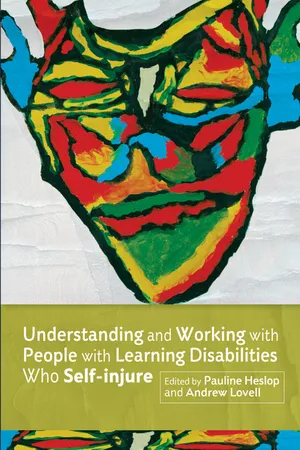
Understanding and Working with People with Learning Disabilities who Self-injure
- 160 pages
- English
- ePUB (mobile friendly)
- Available on iOS & Android
Understanding and Working with People with Learning Disabilities who Self-injure
About This Book
Adopting a predominantly psychological approach, this book provides carers with up-to-date information and resources to provide appropriately individualised care to people with learning disabilities who self-injure.
Understanding and Working with People with Learning Disabilities who Self-Injure synthesises traditional (behavioural) and newer (psychological) approaches to understanding self-injury, drawing on psychoanalytic and social theory to provide practical guidelines for more sustained and effective support. It suggests that motivations for self-injury may be similar for people with and without learning disabilities, and draws on case work examples to suggest person-centred techniques that encourage communication – particularly important with people who do not use verbal communication - and recovery. The book covers a range of specific needs, including people with autism who self-injure, and emphasises the views of people with learning disabilities themselves and their families about what has worked best, and why. At the end of each chapter, a variety of practical implications for the provision of support are given.
This book is for those supporting people with learning disabilities who self-injure and will be a useful resource for social workers, psychologists, counsellors, learning support workers, nurses and social and health care students.
Frequently asked questions
Information
Table of contents
- Cover
- Title
- Copyright
- Contents
- Acknowledgements
- Chapter 1: Introduction
- Part 1: Different Approaches to Understanding Self-injury
- Chapter 2: Dimensions of Self-injury
- Chapter 3: Social Approaches to Understanding Self-injury
- Chapter 4: Psychoanalytic Approaches to Understanding Self-injury
- Chapter 5: The Voice of Experience: People with Learning Disabilities and Their Families Talking About How They Understand Self-injury
- Part 2: Different Approaches to Working with People Who Self-injure
- Chapter 6: Minimising Harm
- Chapter 7: What People with Learning Disabilities Say Helps Them
- Chapter 8: Family Voices
- Chapter 9: Psychoanalytical Approaches in Practice 1
- Chapter 10: Psychoanalytical Approaches in Practice 2
- Chapter 11: Self-injury and Loss of Sense of Self
- Chapter 12: A Relational Approach to Understanding Our Responses to Self-injury
- Chapter 13: Concluding Comments: Towards an Integrated Approach to Self-injury and Summary of Implications for Practice
- References
- Contributors
- Figure 2.1 The spectrum from self-harm to self-injury and the possible positioning of different types of behaviours
- Table 5.1 Research identifying the personal perspectives of people with learning disabilities who self-injure